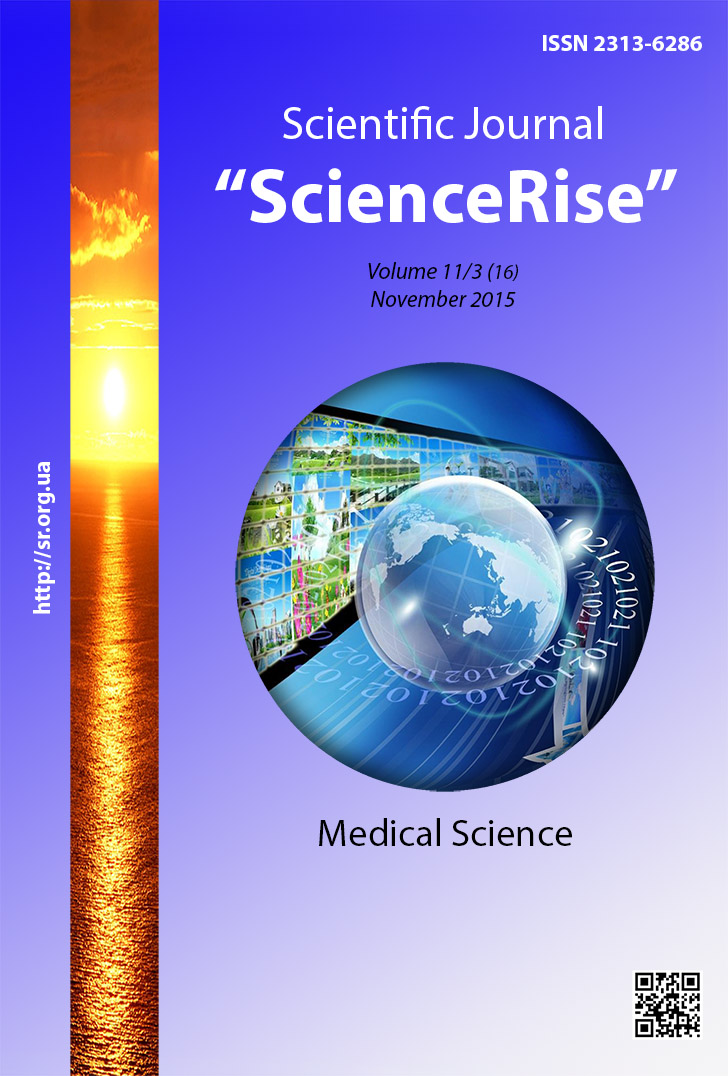The special features of cardiovascular pathology diagnostics in patients with epilepsy
DOI:
https://doi.org/10.15587/2313-8416.2015.53995Keywords:
epilepsy, cardiovascular pathology, myocardial work index, antiepileptic preparations, cardiovascular riskAbstract
Aim. The researchers noticed the changes of parameters of cardiovascular system functioning in patients with epilepsy during epileptic attacks and in interictal period. The aim of research was the study of informativity of the different methods of study of cardiovascular system functioning for detection and evaluation of risk of cardiac pathology development in patients with epilepsy.
Materials and methods. We examined 50 patients with epilepsy and CVP and 50 patients with epilepsy without CVP. All patients underwent clinical and neurological examination, electrocardiography, echocardioscopy, examination of heart rhythm variability, dopplerography of carotid arteries, analysis of lipid blood spectrum, brain evaluation on indications on SCORE, МРТ.
Results. There was revealed that the use of valproates and carbamazepine is associated with dyslipidemia development; valproates – with increase of intima-media complex thickness, cambamazepine – with increased risk of development of heart rhythm and conduction disorder; lamotrigine and levetiracetam – with increase of heart rate. The combined use of levetiracetam and carbamazepine is associated with extension of QT interval. The most significant increase of risk of CVP development during the next 10 years on SCORE was noticed in patients who take carbamazepine.
Conclusions. The definition of intima-media complex thickness at dopplerography of carotid arteries, patients evaluation on SCORE, lipidograms, heart rhythm variability, definition of myocardial work index at echocardioscopy along with the standard ECG are effective for determination of risk factors and early detection of CVP in patients with epilepsy
References
Karlov, V. (2010). Epilepsiya u detei i vzroslih, genshin i mugchin женщин и мужчин [Epilepsy in children and adults, women and men]. Moscow: OAO «Izd. Medicina», 720.
Nagaraddi, V.; Lüders, H. (Ed.) (2008). Autonomic seizures. Textbook of Epilepsy Surgery, 443–449. doi: 10.3109/9780203091708-59
So, E. L. (2008). What is known about the mechanisms underlying SUDEP? Epilepsia, 49, 93–98. doi: 10.1111/j.1528-1167.2008.01932.x
Shorvon, S., Peracca, E., Engel, J. (2009). The Treatment of Epilepsy. Third Edition. Blackwell Publishing Ltd., 840.
Cardiol, J. , Karabin, B., Kanjwal, Y., Grubb, B. P. (2010). Autonomic dysfunction presenting as postural tachycardia syndrome following traumatic brain injury. Cardiol. J., 17 (5), 482–487.
Eggleston, K. S., Olin, B. D., Fisher, R. S. (2014). Ictal tachycardia: The head–heart connection. Seizure, 23 (7), 496–505. doi: 10.1016/j.seizure.2014.02.012
Jansen, K., Lagae, L. (2010). Cardiac changes in epilepsy. Seizure, 19 (8), 455–460. doi: 10.1016/j.seizure.2010.07.008
Bozorgi, A., Chung, S., Kaffashi, F., Loparo, K. A., Sahoo, S., Zhang, G. Q. et. al (2013). Significant postictal hypotension: Expanding the spectrum of seizure-induced autonomic dysregulation. Epilepsia, 54 (9), e127–e130. doi: 10.1111/epi.12251
Philippe, R., Lina, N., Samden, D. L. et. al (2013). Incidence and mechanisms of cardiorespiratory arrests in epilepsy monitoring units (MORTEMUS): a retrospective study. The Lancet Neurology, 12 (10), 966–977.
Sauer, A. (2007). Long QT syndrome in adults. J. Am. Coll. Cardiol., 49 (3), 329–337. doi: 10.1016/j.jacc.2006.08.057
Downloads
Published
Issue
Section
License
Copyright (c) 2015 Валерия Николаевна Гримайло, Татьяна Анатольевна Литовченко, Игорь Николаевич Пасюра, Анна Анатольевна Новикова

This work is licensed under a Creative Commons Attribution 4.0 International License.
Our journal abides by the Creative Commons CC BY copyright rights and permissions for open access journals.
Authors, who are published in this journal, agree to the following conditions:
1. The authors reserve the right to authorship of the work and pass the first publication right of this work to the journal under the terms of a Creative Commons CC BY, which allows others to freely distribute the published research with the obligatory reference to the authors of the original work and the first publication of the work in this journal.
2. The authors have the right to conclude separate supplement agreements that relate to non-exclusive work distribution in the form in which it has been published by the journal (for example, to upload the work to the online storage of the journal or publish it as part of a monograph), provided that the reference to the first publication of the work in this journal is included.

